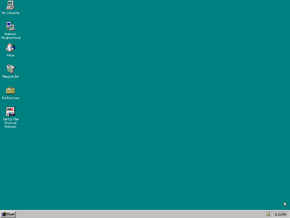Windows 9x
 The Desktop in Windows 95, the first release in the Windows 9x series | |
| Initial release | Windows 95 (24 August 1995) |
|---|---|
| Final release | Windows Me (14 September 2000) |
| Supported platforms | 32-bit x86 |
| Kernel type | Monolithic (VMM) |
| Preceded by | Windows 3.1x |
| Succeeded by | Windows XP |
Windows 9x refers to a series of Microsoft Windows operating systems released between 1995 and 2000. It was introduced with Windows 95, a major update to the MS-DOS-based Windows line that added support for 32-bit user applications, as well as greatly overhauled the user experience with the introduction of the Windows Explorer. It was succeeded by Windows 98 and then by Windows Me in 2000. After that, the series was discontinued and ultimately superseded by Windows XP in 2001.
The series was envisioned as a stopgap to ship a 32-bit consumer version of Windows, as Windows NT at the time was too heavy to run on an average home computer. One of the design constraints of Windows 95 was the ability to run on an average Windows 3.1 machine with a 386 processor and 4 MB of RAM. However, Windows NT required at least three times as much memory and could not be reasonably cut down without major changes to the architectural design. Once home systems became powerful enough to run Windows NT, it was decided to ultimately discontinue the Windows 9x series.
Architecture[edit | edit source]
The architecture of Windows 9x builds on the 386 Enhanced Mode of Windows 3.0 and Windows 3.1x, the key component of which is the 32-bit virtual machine monitor (VMM32) that utilizes the Virtual 8086 mode of the i386 processor, enabling the execution of 16-bit real mode code in the otherwise 32-bit protected mode. However, the key difference between 16-bit Windows and Windows 9x is the ability to run Win32 applications, although simpler applications could already run under Windows 3.1 using the separately available Win32s supplement.
MS-DOS[edit | edit source]
The Windows 9x line uses a modified version of MS-DOS that includes major changes to improve cooperation with the Windows environment. It is used to bootstrap Windows on boot, as well as to provide the environment for virtual DOS machines and MS-DOS device drivers.
The MS-DOS subsystem originally identified as MS-DOS 7.0 in Windows 95, and was followed by two major updates throughout the series. MS-DOS 7.1, introduced as a part of the Windows 95 OEM Service Release 2, notably added support for the FAT32 filesystem. MS-DOS 8.0, shipping with Windows Me, then considerably cut down access to real mode MS-DOS to improve Windows boot times. Neither version was ever available as a standalone retail product, although unofficial repacks of the DOS subsystem of the respective Windows versions exist and tend to be mislabeled as actual standalone MS-DOS versions.
The integration of MS-DOS into Windows was a subject of a major lawsuit by Caldera, the developer of the competing DR-DOS operating system, who viewed this as an anticompetitive measure. The company has later demonstrated Windows 9x running on top of a custom version of DR-DOS that included the functionality necessary to boot the environment. In 2000, Microsoft settled out of court for an undisclosed sum, which was later revealed to be $280 million.
Thunking[edit | edit source]
Similar to Win32s, many Win32 APIs are implemented by thunking to Win16. For example, most of GDI and USER involves thunking into 16-bit code, since display drivers remain 16-bit for compatibility. Since the 16-bit components of Windows were expected to be called from a cooperatively-multitasked environment where one system call would finish before another process could make one of its own with explicit serialization/synchronization points, it was non-reentrant. To compensate, for this, Microsoft introduced the Win16Lock (later known as the Win16Mutex), which could block any threads from performing a Win16 call while another Win16 call was in progress. This compromised the preemptively-multitasking nature of the OS, and allowed a misbehaving 16-bit (or even 32-bit) application to affect system responsiveness, through pressing CTRL+ALT+DEL would forcibly release the Win16Mutex.
Resource exhaustion was a major issue early in the development of Windows 95, since many graphics objects were allocated from 64KB heaps (with many USER and GDI "handle" objects merely being near pointers into the data segments for USER and GDI), but Microsoft reworked many of those objects to instead come from 32-bit heaps, accessed via 32-bit offsets, though still inside of the 16-bit GDI and USER.
List of versions[edit | edit source]
| Name | Codename | Version | Build no. | Release date | Support end date | Components | |||||
|---|---|---|---|---|---|---|---|---|---|---|---|
| Mainstream | Extended | DOS | IE | DX | WMP | ||||||
| Windows 95 | Chicago | 4.00 | 950 | 1995-08-24 | 2000-12-31 | 2001-12-31 | 7.0 | — | — | — | |
| OEM Service Release 1 | — | 950a | 1996-02-14 | 2.0 | |||||||
| OEM Service Release 2 | 1111 | 1996-08-30 | 7.1 | 3.0 | 2.0a | ||||||
| OEM Service Release 2.1 | 4.03 | 1212 | 1997-07-27 | ||||||||
| OEM Service Release 2.5 | 1216 | 1997-11-26 | 4.0 | ||||||||
| Windows 98 | Memphis | 4.10 | 1998 | 1998-06-25 | 2002-06-30 | 2006-07-11 | 5.2 | ||||
| Second Edition | — | 2222A | 1999-05-05 | 5.0 | 6.1 | 6.1 | |||||
| Windows Me | Millennium | 4.90 | 3000 | 2000-09-14 | 2003-12-31 | 8.0 | 5.5 | 7.1 | 7.0 | ||
